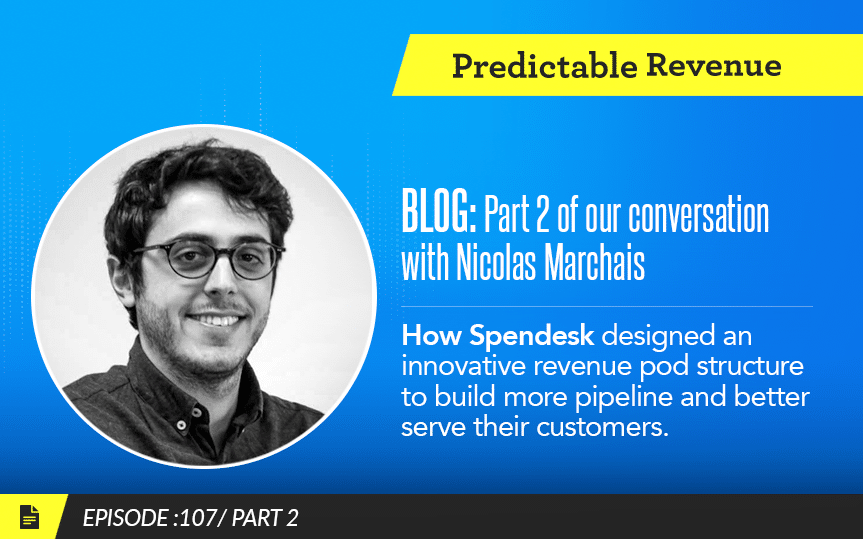How Spendesk Designed an Innovative Revenue Pod Structure to Build More Pipeline

Last week, we discussed the various lessons Nicolas Marchais and the team at Spendesk learned as they rapidly scaled their sales team to 25 reps in just three years.
But that isn’t all Marchais had to say about sales – far from it, in fact. In addition to their rapid growth (and all of the lessons that come along with that), Spendesk has also been at the forefront of developing unique and progressive sales team frameworks and processes.
That’s why we’re discussing his, and Spendesk’s, innovative revenue pod structure on this edition of The Predictable Revenue Podcast.
“We built the revenue pod because we were seeing misalignment between who sales were going after, and who makes a good customer,” says Machais.
“It is like a soccer team. Every member has a job to do, but the output is the same – winning the match and closing the deal.”
Spendesk’s innovative revenue pod structure
So…what are Spendesk’s revenue pods? How are they designed?
Think of each revenue pod as a self-contained prospecting, sales, and onboarding unit comprised of an SDR, an Account Executive, a Customer Success Manager, and an onboarding manager (although the Customer Success and onboarding managers can support other revenue pods as well).
“It’s about having 4 stakeholders, all working towards the same goal,” says Marchais, adding that, in some cases, they have even merge pods to have up to 4 SDRs working to support AEs.
But, it hasn’t always been this way. In fact, when Spendesk first started, they had full-stack sales reps responsible for prospecting, closing, and some Customer Success functions. Then, as they grew, they transitioned to a more traditional SDR–AE sales model, before adopting their current pod structure.
That evolution, despite having been achieved over the course of a couple years with different iterations along the way, has a unified theme at its core: how to best serve the customer.
“This newer process is longer. The SDR starts the conversation, and decides which direction to take the deal. And the AE on the pod gets into more in-depth discovery, to build the business case,” says Marchais.
“The main lesson is having specialists. Salespeople today have to be enablers – they cannot block.”
(Editor’s note: we had Margaret Weniger on the podcast a while back to discuss building diverse sales teams. You can read about our chat here, or listen to our interview here)
Spendesk’s growth marketing team
Fueling the work of the revenue pod is Spendesk’s growth marketing team.
That team, comprised of growth engineers, is tasked with developing Spendesk’s lead scoring system, building scrapers to populate their CRM with accurate data and on their prospective accounts, and any relevant news (finding, hiring, etc.) that Spendesk’s reps can use to personalize their messaging.
“This team gets and enriches the data the sales team uses. They use in-house tools, and tools from the market. And we outsourced some of the repetitive tasks to outsource support with virtual assistants. Today, we can source 2,000 companies per week – with 3 contacts at each,” says Marchais.
“So, reps have a list of accounts ready to be engaged. This team supercharges the sales org.”
Despite those supercharging abilities, Marchais warns it can breed some negative traits in sales reps.
“Having that kind of support is a great thing, but you can forget the basics. We invested heavily in our growth marketing team. The reps were fed very easily, so they forget a bit about what it was like to source the leads themselves,” says Marchais.
“So, we got a bit lazy, and burned through some leads to quickly. Now we limit it to 300 – 400 accounts per quarter. If they need more, we talk. But we make sure we are working leads more thoroughly.”
The metrics…and responsibilities
Based on Spendesk’s SMB or mid-market team, SDRs are expected to bring in 15 new opportunities per month. Account Executives, on the other hand, are tasked with bringing in monthly new revenue, while the onboarding manager works to bring a customer on to the product as quickly as possible.
Finally, the Customer Success manager focuses on upselling and preventing churns.
“This breakdown shows that you care about your prospects, and that you are prepared to invest resources in a deal. Customers see that, and they appreciate it.”
Like their team composition, Spendesk’s compensation plans have also evolved. At first, their comp plans were team-based and entirely based on new MRR. Then, they added deployment time – how quickly can the team get the customer up and running? So, not only were commissions paid out on new revenue, but also on how successful that new revenue was with getting up and running on their platform.
“There are a lot of models, but just make sure you are choosing something that aligns with what you need today. And, as you evolve, you change it,” says Marchais.
We still want to foster collaboration – so we make sure no matter how we change our comp plans, they remain in line with our values.”